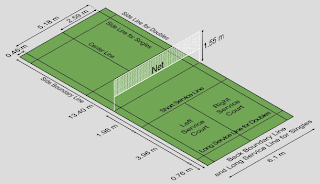Comparisons of speed and athletic requirements
Statistics such as the smash speed, above, prompt badminton enthusiasts to make other comparisons that are more contentious. For example, it is arguely stated that badminton is sthe fastest racquet sport. Although it keeps the record for the fastest initial speed of a racket sports projectile, the shuttlecock decelerates substantially faster than other projectiles such as tennis balls. In addition, this qualification must be fullfilled by regarding distance over which the shuttlecock travels. It is understandable that a smashed shuttlecock travels a shorter distance than a tennis ball during a serve. So the claim for being a fastest racquet sport might also be based on reaction time requirements, but arguably table tennis requires even faster reaction times.

While fans of badminton and tennis often claim that their sport is the more physically demanding, such comparisons are difficult to make objectively because of the differing demands of the games. No formal study currently exists evaluating the physical condition of the players or demands during game play.
Comparisons of technique
Tennis and Bedminton both a different techniques. The light weight of racket and of the shuttlecock allow badminton players to make use of the wrist and fingers much more than a tennis players.
In tennis the stablity of wrist is required and the players have to avoid playing with a mobile wrist because it may lead to injusry. For the same reasons, badminton players can generate power from a short racket swing: for some strokes such as net kills, an elite player's swing may be less than 5 cm (2 in). Strokes that need more and more power to play, a long swing will be used, but the badminton racket swing will rarely be as long as a typical tennis swing.
The assertion takes us to the phenomena that while playing badminton strokes requires more power that mainly comes from wrist. This quote may be criticised for two reasons. First, it is strictly speaking a category error: the wrist is a joint, not a muscle; the forearm muscles control its movement. Second, wrist movements are weak when compared to forearm or upper arm movements. Anyhow some studies refer the generation of the power from wrist has a role at a minor level, and indicate that the major contributions to power come from internal and external rotations of the upper and lower arm.
Badminton evolved as Olympic sport in 1992. London 2012 Olympic will see Badminton being contested in Wembley Arena from Saturday 28 July to Sunday 5 August. Badminton fans can get
Olympic Badminton Tickets from
Sport Ticket Exchange.















